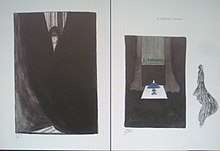Intruder (play)
Intruder (French: L'Intruse)[1] a play by Belgian playwright Maurice Maeterlinck. It is the second play Maeterlinck wrote.
| Intruder | |
|---|---|
 L'Intruse - with illustrations by Léon Spilliaert (1903) | |
| Written by | Maurice Maeterlinck |
| Date premiered | 20 May 1891 |
| Genre | Symbolism |
Intruder concerns man's conflict with preternatural forces, against which he is powerless.[2] The same theme was prevalent in Maeterlinck's first written play, Princess Maleine.
Premiere
The first performance of Intruder occurred at Paul Fort's Theatre d'Art in Paris on May 20, 1891. The play was to appear at the end of a program benefiting Paul Verlaine and Paul Gauguin. If the program went on too long, then the play was to be removed.[3] Intruder was a success and received praise from many critics.[4]
Synopsis
Set in the living room of a home, the grandfather, who is blind, waits with the father, the uncle, and the three daughters. They wait for the arrival of the priest and the sister. The ailing mother, who is in the next room, has given birth to a child, who sleeps in another adjoining room.
After hearing many noises, the grandfather hears two sets of footsteps upon the staircase. The maid appears, saying the door was open, so she shut it. The grandfather claims he heard someone enter the room behind the maid, but the others in the room say she was alone. The clock strikes midnight, the baby commences screaming, and the Sister of Mercy appears, announcing the death of the mother. It became clear that the intruder being referred to by the old man was death itself.[5] Later, Maeterlinck would explain the dominance of this element (which was recurring in his other plays) so that it was almost treated as a character in the narrative: "This Unknown takes on, most frequently, the form of Death. The infinite presence of death, gloomy, hypocritically active, fills all the interstices of the poem. To the problem of its existence no reply is made except by the riddle of its annihilation."[6]
Techniques
Maeterlinck used several unconventional literary devices in The Intruder. He used buildings to dramatize patterns of behavior such as how the house came to represent a form of introversion in which libido (psychic energy) flows inward.[7] There is also the case of word repetitions, which could strike the audience as unnecessary or an oversight on the part of the author.[8] Maeterlinck, however, employed this technique in several of his plays to enhance the atmosphere of the supernatural, horror, fear, gloom, and awe. There are observers who likened this to what Edgar Allan Poe aimed for with his liberal use of the rhyme "ore" in The Raven.[8]
References
- http://www.theatrehistory.com/plays/intruder.htmlis%5B%5D
- Maurice Materlinck, Bettina Knapp, (Twayne Publishers: Boston), 41.
- Maurice Maeterlinck, Knapp, 40.
- Maurice Maeterlinck, Knapp, 48-9.
- Booth, Francis (2011). The Marionette Plays of Maurice Maeterlinck. Raleigh, NC: Lulu Press. p. 7. ISBN 9781447776628.
- Bithell, Jethro (1916). Contemporary Belgian literature. New York: F.A. Stokes company. pp. 167.
- Knapp, Bettina (1986). Archetype, Architecture, and the Writer. Bloomington: Indiana University Press. pp. 13. ISBN 0253308577.
- Brown, Edmund (1987). Five Modern Plays. Boston: International Pocket Library. p. 75. ISBN 9780828314350.
| Wikimedia Commons has media related to L'Intruse (Maeterlinck). |